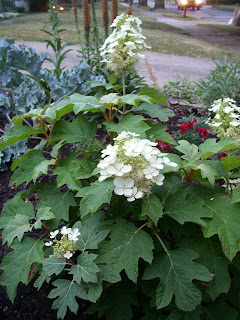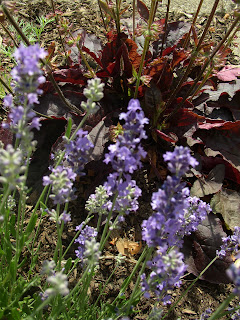 The first plant is my 'Sykes' Dwarf' oakleaf hydrangea. In my humble opinion, oakleaf hydrangeas (hydrangea quercifolia) speak for themselves. They are such stately plants, with white panicles, handsome leaves, and good form. That their foliage takes on jewel-toned hues in fall--and the bark and dried flowerheads add a ton of winter interest to the garden as well--seems almost too much to get from one shrub.
The first plant is my 'Sykes' Dwarf' oakleaf hydrangea. In my humble opinion, oakleaf hydrangeas (hydrangea quercifolia) speak for themselves. They are such stately plants, with white panicles, handsome leaves, and good form. That their foliage takes on jewel-toned hues in fall--and the bark and dried flowerheads add a ton of winter interest to the garden as well--seems almost too much to get from one shrub.This one is an anchor of sorts in my front bed. It gives the eye a quiet place to rest amid the riot of the blue crambe maritima foliage, rusty Spanish foxglove spires, dark red snapdragon flowers and multiple purple- and yellow-leaf plants.
 The second plant is anything but quiet. The canna 'Wyoming' has large, dusky purple leaves highlighted by a lavender flower spike and sherbet-orange blooms. This is one of those plants that screams, "look at me!" and was planted as a focal point in an otherwise unassuming bed.
The second plant is anything but quiet. The canna 'Wyoming' has large, dusky purple leaves highlighted by a lavender flower spike and sherbet-orange blooms. This is one of those plants that screams, "look at me!" and was planted as a focal point in an otherwise unassuming bed.Here, the dark, misty haze of bronze fennel that screens the air conditioning unit from view both highlights the leaf texture and helps its color blend in. The aging goatsbeard flowers are turning a warm tan that echoes the orange of the canna flowers (I wish I could say that was planned, but it's a happy accident) in a way that ties the canna in to the rest of the bed. The multiple grasses in that area make foliage seem like more of a focus here, further mitigating the bright bloom.
Originally, this post was going to be a quick, "Okay, I was wrong--work or no, I can't stop posting when I have new flowers in the garden" kind of post. But as I looked at the pictures of these two very different plants, I was struck how much their supporting cast of plants affected them.
Generally, you see oakleaf hydrangeas in naturalistic, quietly beautiful gardens. Cannas are most often seen in hot, colorful borders. Both are filling new roles here and surprising even the person who planted them. Makes me wonder what other plants should be reevaluated... and maybe given a different supporting cast...












